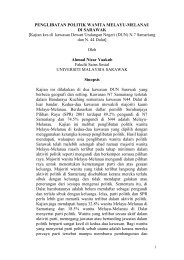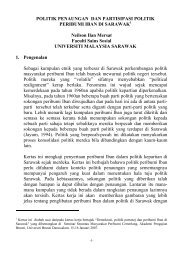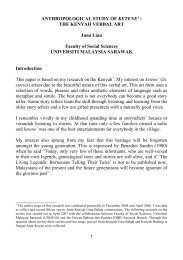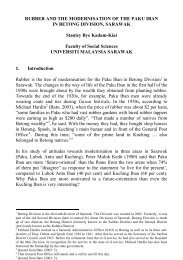OF SOUKHUAN AND LAOS Elena Gregoria Chai Chin Fern Faculty ...
OF SOUKHUAN AND LAOS Elena Gregoria Chai Chin Fern Faculty ...
OF SOUKHUAN AND LAOS Elena Gregoria Chai Chin Fern Faculty ...
Create successful ePaper yourself
Turn your PDF publications into a flip-book with our unique Google optimized e-Paper software.
13th century, the Lao Loum adopted it as their national religion under the strong<br />
patronage of King Fa Ngum. The Lao Loum is the dominant group which is made up<br />
of a few ethnic groups residing in the Mekong valley. The Lao also inherited some<br />
Hinduism through the influence of Cambodians, who were very devout Hindus<br />
themselves.<br />
King Fa Ngum was believed to be the founder of the Lao Kingdom in 1353. He was<br />
brought up in a Cambodian court and was married to a Cambodian princess. Thus, the<br />
strong influence of Cambodian or Khmer civilization in old Lao or Lang Xang<br />
Kingdom is evident. When the Lao Loum adopted Buddhism in the 13 th century, preexisting<br />
cults and beliefs were modified and incorporated into Buddhism. Phya<br />
Anuman Rajadhon (1962) was one of the leading scholars to have spotted such<br />
syncretism.<br />
Another leading scholar on religion in Laos, Marcel Zago (1972) mentioned,<br />
“animism and Buddhism form a structural religious unity and appear as two<br />
components or subsystems of the unique religion of Laos” (1972:380). However, he<br />
also mentioned that the functions of animism and Buddhism are different. He noted<br />
that, “With regard to animism, the Lao searches for well-being and terrestrial<br />
protection, while the shift to Buddhism is in response to essential problems of life, a<br />
way of extra-temporal salvation” (1972:380).<br />
Martin Stuart-Fox (1982) explained further, “It can be said that in Laos, obeisance to<br />
the spirit world, to a degree unsurpassed in other Southeast Asian Theravadin<br />
Buddhist societies, does not conflict with the adept’s private spiritual quest for the<br />
accumulation of merit” (1982:64).<br />
In the soukhuan ceremony, there can be Buddhism, Hinduism and animistic elements<br />
incorporated into one ceremony and it can be difficult to single out the different<br />
religious elements. In a seminar on Buddhism and Civilization held on 11 December<br />
2001 (Vientiane Times, 11-14 Dec 2001), the director of Ong Teu’s Buddhist<br />
University in Vieng Chan, Abbot Boukham Saribouth said, “Buddhism originally<br />
entered Laos twice but could not win over the Brahmin and animism, which were the<br />
original beliefs of local people. The first arrival of Buddhism in Laos was more than<br />
2000 years ago during the time of the landlords. This was a time of strength and unity<br />
in original beliefs. Buddhism was easily swallowed by the two older beliefs of<br />
Brahminism and animism. In the 14th century, King Fa Ngum united an area covering<br />
much of modern Laos and adopted Buddhism as the official religion. This was the<br />
emergence of a great movement among Lao people to replace Brahmanism and<br />
animism which were still buried deeply in the hearts of many communities. However,<br />
only the kings and landlords practised Buddhism for their own interest. The people<br />
were discouraged from practicing it. Thus the spread of Buddhism was interrupted and<br />
the belief in the other two older beliefs returned. Today, Lao people integrated<br />
Buddhism in their older beliefs and through centuries, such integrated beliefs has<br />
- 4 -<br />
PDF Creator - PDF4Free v2.0<br />
http://www.pdf4free.com







